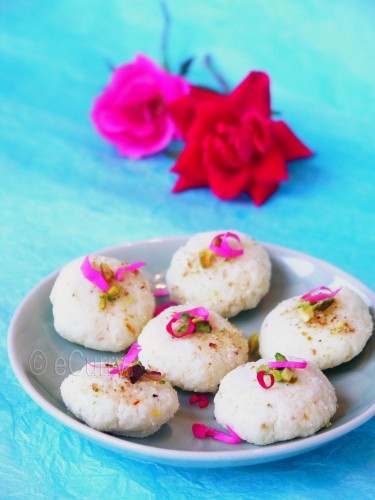
“Shondesh” is what it is called in West Bengal, “Sandesh” it is elsewhere, & Cheese Fudge is the closest translation I can come up with. “It’s dry yet moist in sweetness. It won’t exactly melt in your mouth but its sweet aftertaste lures your taste buds to bite into more such soft wonders. That, ladies and gentlemen, is the mysterious charm of Sandesh — a term meaning news — a bearer of good tidings for those away from home.” (The Times of India)
This is probably the longest post I have written in a year. I need to elaborate on the Sandesh & the concept, all the more since I found out that even the Wikipedia has incorrect information about this so authentic recipe. This also is a post heavy with nostalgia & memories; memories of festivals & special occasions, of pots of milk boiled, of big brass plates where the “Sandesh” were neatly arranged while we tucked ourselves, sat on the floor & looked in awe as they got magically moulded with experienced fingers, of giggles & laughter & happiness & mouthful of homemade Sandesh melting away smoothly while the little palms stretched asking for more – typical scene in every home.
If you want the recipe right now, scroll down for an illustration of the procedure. It is a fairly easy recipe.
For those of you who are not aware, West Bengal is a state on the Eastern Regions of India, with the southern parts hugging the coasts of the Indian Ocean & the mountains lining the northern parts. In Bengal “sweets” & the culture is interwoven. “Bengali” is the language spoken in Bengal, & is known to be the “sweetest” – it is lyrical, poetic & beautiful. So are the cuisine & the people. Can you say I belong to West Bengal?:-)
Life in my state revolves around “Mishti” (Sweets), Fish, Adda (Gossip/Chat/Dialogue) & Literature. The cuisine is varied, with a love affair with everything sweet. The everyday meals are incomplete without a sweet note – usually some kind of sweet fruit chutney. When guests grace the home, what is offered is a big plate full of sweets along with tea, either store bought or home made. No they are not cakes & cookies.
To be precise, Sandesh & most of the sweet meats of Bengal are made from only “Chenna” (A soft fresh Paneer/the Indian Cheese made with curdled milk), & Sugar in their basic form, butter or ghee is rarely being used in these; forget the flour, cornflour & the condensed milk used in the “modern” versions. Using flavorings, garnishes & other ingredients like fruits, pulps, etc. are an option. The variety, flavors & texture depends on the time of the year & occasion. With all the sweetness flowing, it is only fair that every occasion is marked with multitude of sweets. During weddings & other family celebrations, “Moiras” (people who make the sweetmeats) are hired to come & make a plethora of sweets at home. I would have my grandfather sitting on a chair while the sweets were made, examining them with hawk eyes. One will be amazed by the capacity of a “Bong” to consume these! There are a zillion variety in different shapes & sizes; some are dry (Sandesh), some are syrupy & soaked (Chum Chum, Kalojam, Pantua, Malai Chom Chom etc), others floating in sugar syrup (Rasgulla or Roshogolla). Often the sweet meats are made to look pretty & attractive with nuts, saffron, silver foils & rose petals as garnishes. So Sandesh is not just the food; it is a big part of our culture too.
On every street corner is a shop, where you can see the heaps of very attractive “sweets” neatly arranged on shelves, mostly in a pyramid. Sometimes in the shops you will be able to see the sweets in making. I come from a small town. There still exists a shop there, named “Mahesh Moira“, which must be almost 100 years old, run by a family which sells the best stuff in the town. They do not have lot of variety, only a very few kind of the best “Shondesh”, Rasgulla & Misthti Doi (Sweet Yogurt). They also have not allowed the modernization touch them. This is a shop worth an experience, a visual & a sensual treat. There are different section of the store where one can see the workers do different things. One corner there is someone is boiling & coagulating the milk to make the “Chenna” – the first step. Next comes the kneading of the cheese, which is done on enormous wooden plates, done the primitive way with the palms & fingers. After this, the cooking is done towards the interior. Then the owner along with the others help give the final touch – roll them in shape, in spheres, no fancy shapes here. Sometimes it is sold just as warm “Makha” ( the prepared & ready Sandesh, but not moulded in any shapes; in a lump). There is usually a long line of customers to buy this Makha, freshly ccoked while it is still warm.
During winter the sugar is replaced with “Nolen Gur” (Runny sap of Date palm collected before dawn), transforming the usual white Sandesh to a pale beige & “Nolen Gurer Sandesh” (Sandesh made from Nolen Gur) is an unforgettable flavor – an ultimate ecstasy!
The Sweet Bengali culture of eating & making sweets run in the veins of every Bengali home. While the shops that sell the sweets are in abundance, every home make their own too. Ours was no exception. The recipe is naturally handed down from one generation to another as are these moulds – heirlooms! I got all of moulds that my mom had. I was very little then, but I remember my dad’s grandmother use these; these had been in our family for ever. The moulds are often used to give shapes to Coconut Burfi (Coconut Fudge) too. Most of these moulds are carved out of stone, while some are of wood. If you notice, there is one in the shape of a fish, illustrating the Bengali’s love affair with fish & sweets.
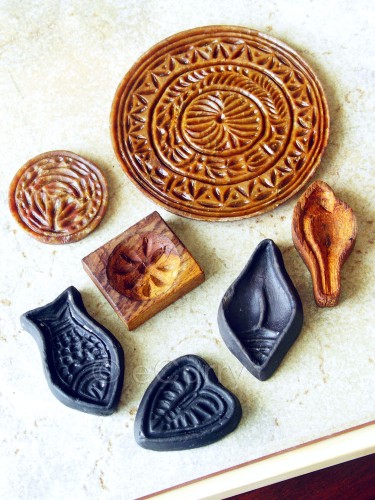
Jai & Bee of Jugalbandi is hosting Meeta’s Monthly Mingle this time. They have combined the theme for the Mingle & the Click, a fantastic theme: Heirloom! I am sending the Sandesh to the Monthly Mingle: Heirloom. I have tried the Ricotta & the Microwave, but I really could not rejoice at my success, for it tasted very far away from home. I cannot let pass this opportunity to pick up my memories & inspirations to create my own moments for my family now – the very authentic way. Ok, now let us get ready for an ultimate gastronomic experience.
Sandesh: Cheese Fudge
Ingredients: (yields about 20 of different sizes & shapes)
To make the Paneer:
- 1 Gallon Whole/Full Fat Milk
- ½ Cup Distilled Vinegar/Lemon Juice
For the Sandesh/Fudge:
- A Generous Pinch of Good Quality Saffron (Optional)
- 3/4 Cup Fine Sugar (more or less to taste)
- 3-4 Tablespoons Pistachios & Almonds combined, made into a powder (The powder should be about 4 tablespoons; dry grind the nuts in a blender or coffee grinder. The powder should be ground to a texture where you can still feel the tiny pieces, but not so coarse that it will not let you mould the cheese.You can use either of the nuts or combine them, or use none at all) + more Pistachios & Organic Rose Petals chopped for garnish (Optional)
Preparation:
Heat milk on medium heat & bring it to a gentle boil. Keep on stirring during this process so the milk does not get burnt at the bottom of the pan.
Stir in vinegar & increase the heat a bit. The milk will start to coagulate.
The coagulation will be completed in a few minutes. Do not overcook/over heat. The moment you see the clear greenish water, switch off the heat. Over cooking will make the chenna/cheese stiff.
Line a colander/sieve with fine cheesecloth. (If you do not have a cheese cloth, any fine cloth will do) Transfer the contents into the lined colander. Spray the coagulated milk with cold water. This washes off any remaining acidic taste. Gather the cheese cloth from the sides & twist it at the top. Let it drain for 45 minutes to an hour.(Now if you want to make only Paneer and do not want to proceed with the Sandesh, this is what you do: after it drains, wrap the paneer with several layers of paper towels or cheese cloth or muslin cloth and place something really heavy, like a cast iron pan or a pot or stack several pans to add some pressure on the cheese. Leave it that way for about an hour to hour and a half. Remove the pan(s), unwrap, and cube the paneer for use in grilling or in a curry.)
This is how it should look:
Continuing with the Sandesh –Take out the Chenna/Paneer after draining.
It is time to knead the chenna now. You can use a food processor, but I usually do it with hand, using the fingers & the heel & the middle of my palms.
Knead evenly for about 7-10 minutes. During the last 3 minutes, add the sugar & the crushed saffron. Knead the chenna/cheese along with the sugar. By this time the chenna/cheese should be very smooth & not grainy at all. You will feel the fat from the cheese glisten on your palms & the cheese itself.
To test if it is done & ready for the next step, take a portion of the chenna/cheese & roll it in a sphere between your palms. The sphere should be very smooth on the outside with no cracks.
This is the crucial & tricky step. The Chenna will be cooked just enough so it does not have the raw cheese taste. If it gets overcooked (which might happen in few minutes time), they will be too crumbly to be moulded, but they will still be edible in the “Makha” form.Take a non stick pan, & put the entire chenna/cheese in the pan. Switch on the stove at a low heat. Spread out the chenna/cheese, & cook it on low heat, while constantly stirring with a spatula so it does not stick at the bottom of pan. This should be done for about 12-15 minutes. You will see it slowly change into a slightly darker shade. The texture will change too. When it is towards done, the chenna/cheese will no longer stick to the pan; it will form lumps & kind of gather together. This particular procedure is called “Paak”.
(Note: While doing the Paak, if you notice that the Chenna is releasing water instead of drying up quick, it would mean that it was not drained well. Don’t panic. It just means that the cheese needs to be cooked a little bit longer. Increase the heat a little bit & cook while contantly stirring & mashing it down with spatula till it reaches the above mentioned state.)
See in the picture below.
Once this stage is reached, quickly take it off the heat & transfer it to a bowl. If the chenna/cheese is heated beyond this, it will form crumbs & you will not be able to mould it into shapes.
The Chenna/Cheese is now ready to be given shapes. This is called “Makha” – the prepared but not yet moulded Sandesh. You have to mould it right away while it is still warm to touch. If left alone for long, it cannot be moulded anymore.
Moulding the Sandesh: Take a portion of the makha, & roll it to a ball or oblong whatever kind of shape you are aiming for. Press it down on the mould, smooth the edges with the fingertips for an even outline & carefully take it out. It helps sometimes to have a bowl of water on the side & wet your fingertips while doing this. Garnish with pistachios, rose petals, saffron – whatever you want it to be.
They will harden a bit & won’t be as fragile when they cool down.
These are the few Sandesh I made with the moulds:
The BIG Sandesh – now that is a bearer of “sweet” tidings…This picture below is being sent to CLICK:Heirloom.
The rest I shaped into little spheres, flattened them & garnished them with pistachios & rose petals.
I cannot even describe in words the joy I got just out of making these. My kids stood & watched me mould the Sandesh, with the same awe & excitement in their eyes, as I would have. This was the best part!
They were just perfect & tasted like home. The ones we get in stores here, are tasteless pieces of mush. I have no idea what they put in them to make them taste so awful. Most of the times the Chenna is not cooked enough or not cooked at all; they are just rolled out into shapes right after kneading them. Often times flour or cornflour is added to the Chenna & that takes the entire essence out of the concept of Sandesh.
The few 20 pieces I made were gone in a few hours & I had to make lot more in the next batch. Arjun has a sweeter tooth then I do; he was REALLY happy with these. The happiness & appreciation I saw in my family’s eyes – ah! one unforgettable moment.
Storing the Sandesh – Cool them & store in the air tight containers in the refrigerator. They stay good & fresh for a week.
Related Posts:
Gujia: Pastry filled with Coconuts, Dry Fruits & Nuts
Dum Aloo: Potatoes simmered in Spices & Coconut Milk
Chola Mix – a ring from the past
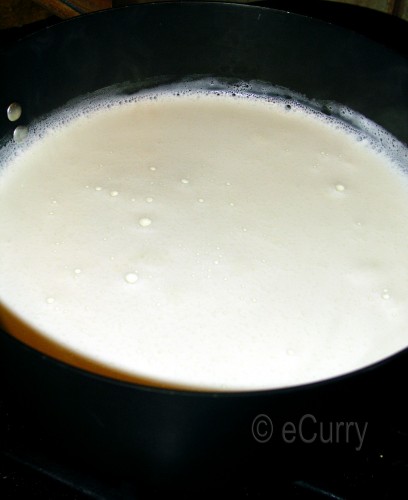
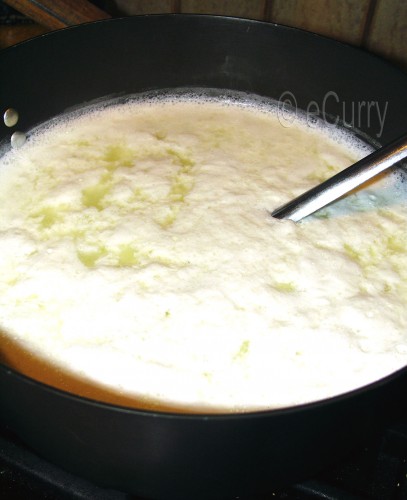
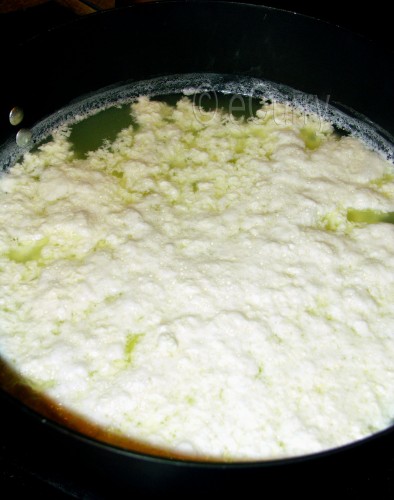
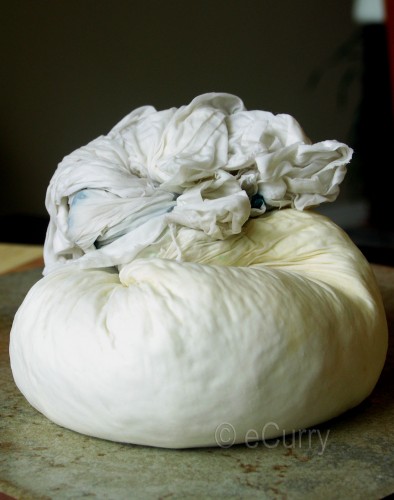
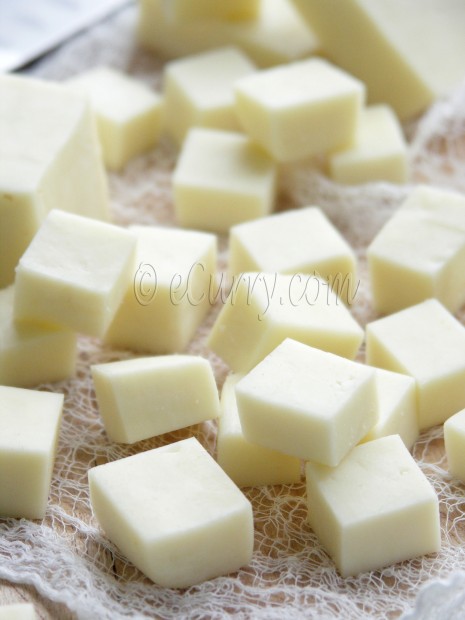
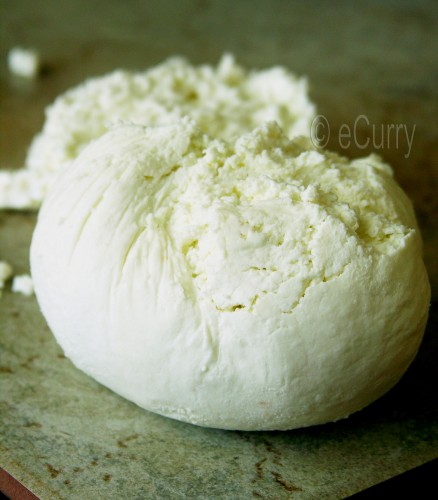
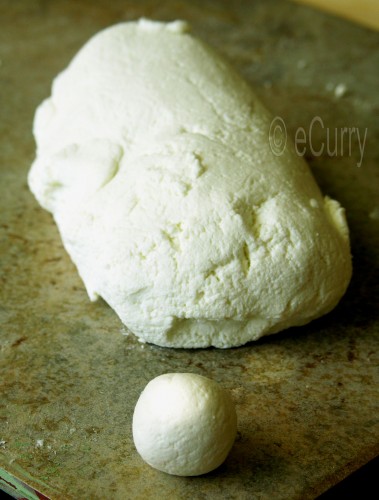
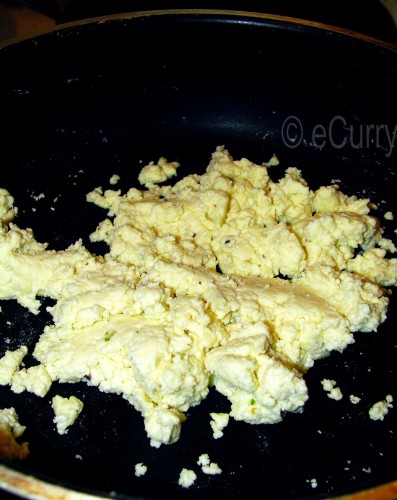
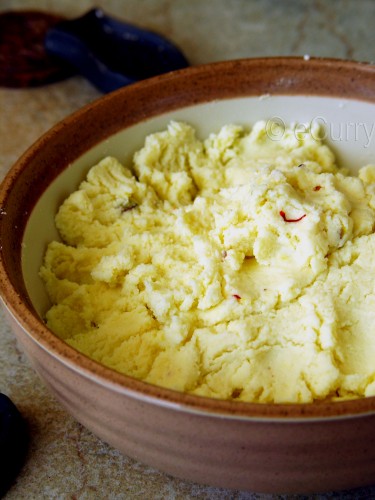
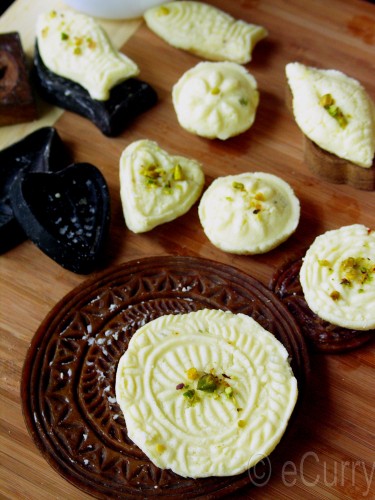
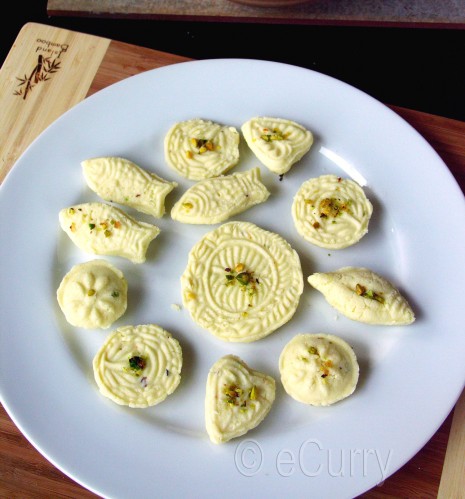
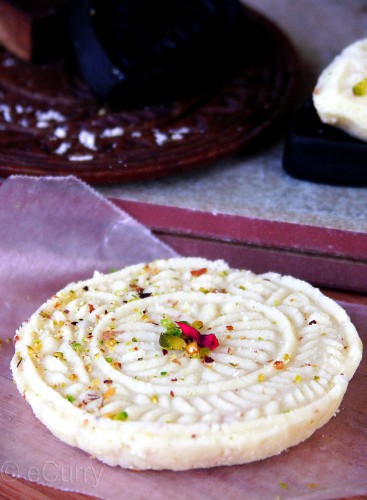
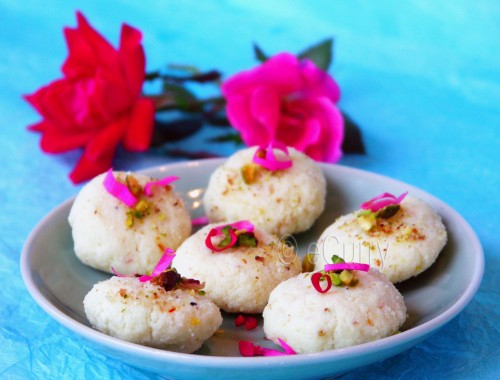

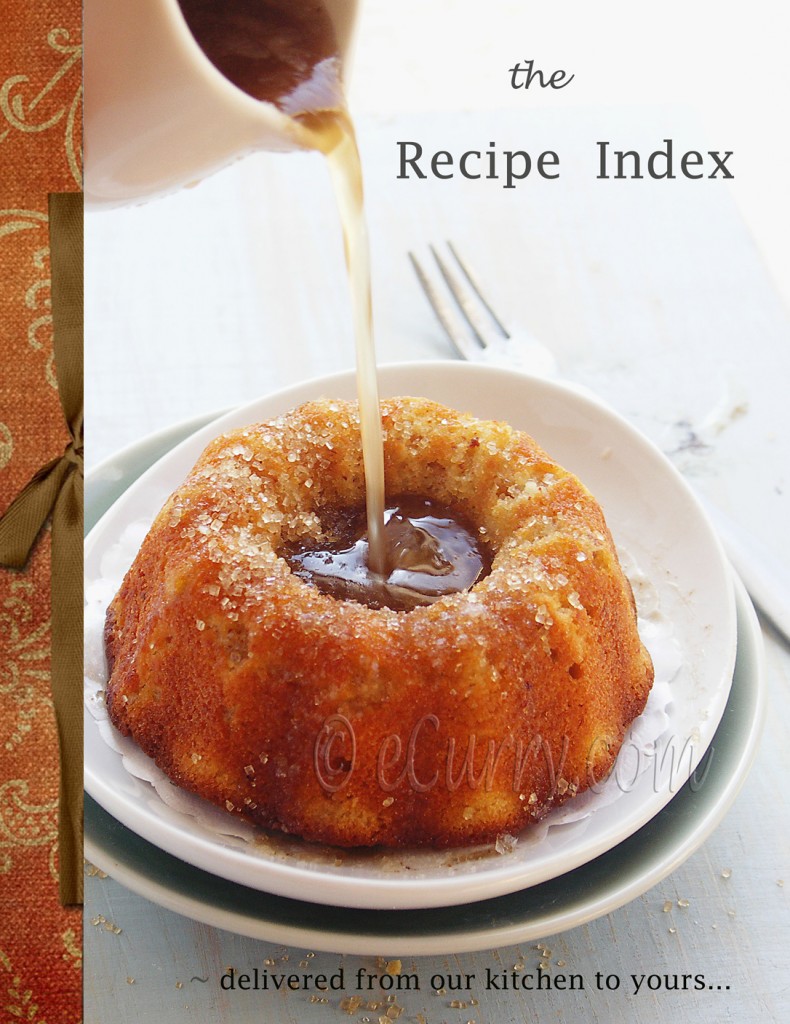
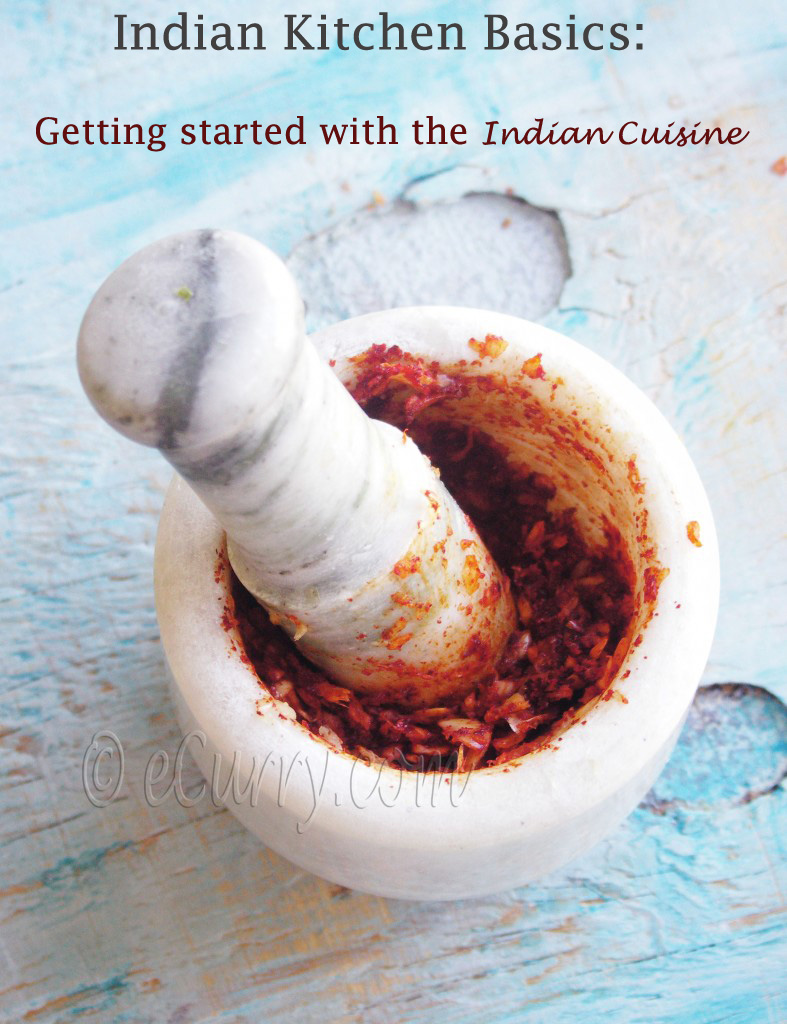
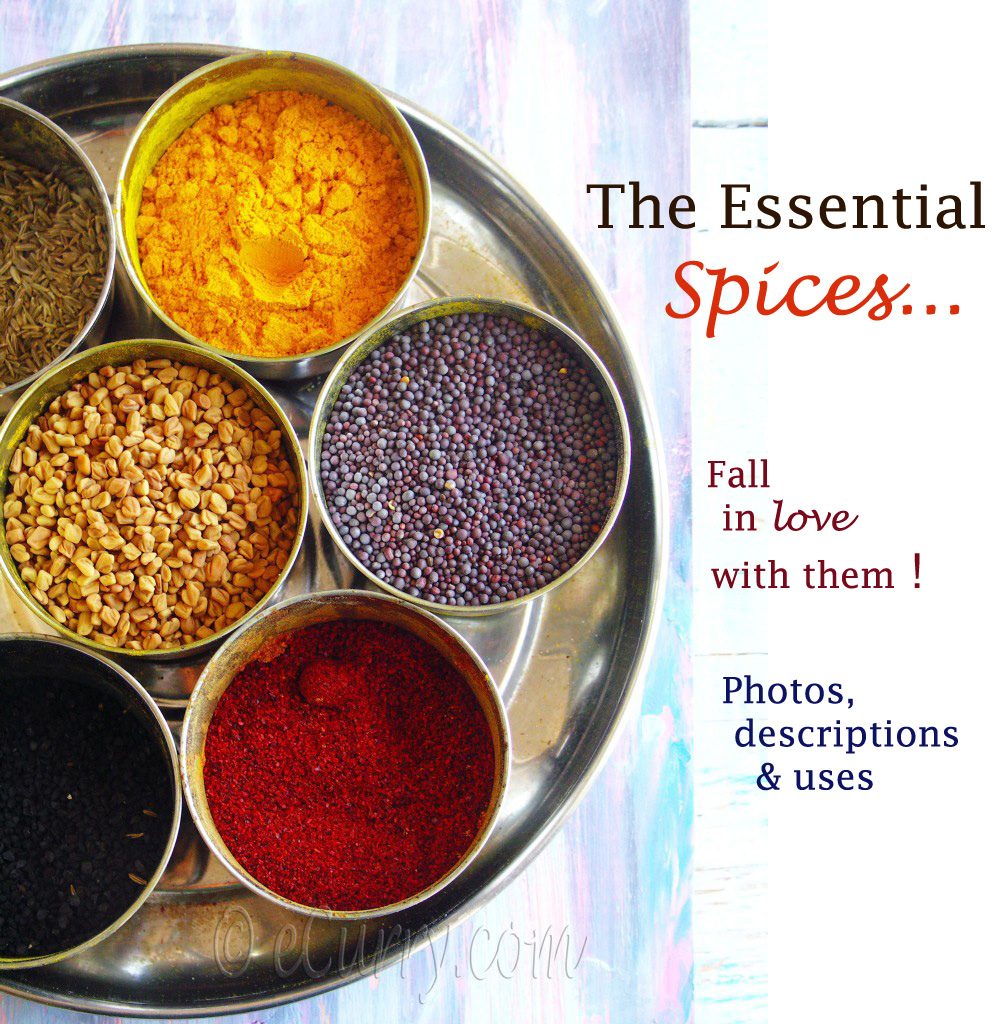








And what about the competions amongst the young as who can down the most number of rosogollas? 🙂
Khub shundor likhecho Soma … koto kotha mone koriye dile. Ar tomar sondesher chaanch gulo toh priceless! Kotha theke collect korecho?! Tomar blog theke aro ekta recipe amar try korbar jonne … ami kokkhono nije sondesh banaini. 🙂
Sharmila, the moulds are all my ma’s which she got from my dad’s grandma:-D (don’t know if she inherited them from anyone else). I got all of ma’s moulds.
Whatever Sandesh I have had from the Indain sweet stores pales in comparison to what you ave here Soma. I have learnt so many things here, including the molds, the procedure, importance etc. The step by step recipe is just wonderful.
These sandesh look like straight from Ganguram :). Nice shots Soma. Tomai abang tomar paribar ke janai Sharidayar abhinandan.
I’m organizing an event on this Puja season in my blog. Hope to get some contributions from you.
Impressing post, I ve never seen these molds anywhere 🙂 Great treasures!
What an interesting post! I learned so much new things… 🙂 Great shots of the finished sandesh, Soma!
Lovely post, Soma! Loved the moulds too – the best rossogulla I’ve had is from those streeside shops in Calcutta – went there only last year.
My full name sometimes has people thinking I’m Bengali. When someone asks me if I was Bengali and I say Yes to fool them, invariably they say “Get Shondesh for me”, Bengali pronunciation and all! 😀
The food in the local small time shops taste the best:-) Do you get the Shondesh? .:-D
awesome pictures and so very well explained!..Soma you have captured the essence so beautifully kudos!
Bengali sweets are my all time favourite..I never seen these moulds yet…awesome clicks..
Sandesh looks superb, very tempting.
Lovely post. I enjoyed reading it and learning so much. I always wanted to make paneer and I have bookmarked your recipe. The molds are fantastic, your photos superb and I am sure the dessert is delicious. By the way what is distilled vinegar? We use wine vinegar in Greece. Will that do or shall I use lemon juice? I’ll come back to check your reply.
Dear Ivy,
Thanks!!
Distilled vinegar is regular vinegar not fermented from wine as are wine vinegars. I think wine vinegars are slightly milder than the other, I am not sure if the wine vinegars have any flavors. Distilled vinegar is the most commonly used in the kitchen even for cleaning. Lemon Juice is good too. Sometimes I save the water that comes out after the milk coagulates, & if I am making cheese soon again this water works really great to curdle the milk & is less acidic.. (might need a little bit more).
if you make paneer, after draining the cheese, press it down with a lot of weight for a few hours. This is to make it firm, so it can be cut into cubes. For this recipe I needed the soft cheese, so I have not done that. I have also heard that using 1 tablespoon of corn flour/corn starch dissolved in the milk, helps to get the paneer firm, tho I have not used that technique yet. HTH.
Hugs
Soma
Beyond lovely Soma. You have captured the love affair of Bengalis with sweets with words and pictures. Even though I am not from Bengal, it made me homesick. Childhood memories are so powerful and everlasting but we sometimes forget them in the fast paced workings of everyday life. Posts like yours bring out the essence of pure joy in unadulterated recipes like Sandesh.
Now I have to go call up my mom and grandma.
This is one sweet that I really miss since my vegan venture! I used to make this so very often. I love your description of the sweet making and the festive atmosphere in this post. Your grandpa reminds me one of my uncles who I recall watching over the cook during one of my cousin’s weddings!
This one is a great topic for heirloom thing. I haven’t used these sandesh moulds at all. One more reason why I should make a Calcutta trip:)
My grandpa would do that too.. sit all night long & supervise the cooks. I think the cooks got a lot bugged:-)
Yummy! I have been yearning for ‘sondes’, as we call it 😉 Looking at the moulds brought back so many memories…of me and ma talking and shaping some…we make it with coconut too. Lovely…but now I’m longing for it even more 🙁 Btw, did I tell you that we were in Kolkata for a year and half, and that both R and A were born there 🙂
oye oye !!! a ha re..sei sheeter diner noler gurer gondho…….
your post transported me to such wonderful nostalgias……..Mahesh Chandra !!! oh wow….
Purano sei diner kotha….
…
..lovely post as usual.
I really wish i had one of those moulds.
I knwo you don’t need the mould but themoul makes it more beautiful.
My hubby and daughte rloves bengali sweets.
Never had Bengali sweets before, this looks gorgeous! I adore the first picture on the top, looks perfect! As I have all the ingredients in my pantry, I can try this out. Thanks for these cultural info and this recipe of an appealing Sandesh.
Soma…these look awesome! And what a detailed step-by-step explanation, admire your passion and talent!
A great step by step post, great recipe, and superb pics,Soma! I have not eaten Sandesh..at least not under that name.There is no parallel to old fashioned milk sweets, I say:)
Soma, so informative post about Bengali sweet and Sandesh. And those moulds are so cute and I knw they are one of best treasures for you gal! 🙂 Really appreciate your effort and dedication. 🙂 btw, I love Bengali sweets. Please post Roso-gulla recipe when you get time. Your Sandesh recipe is bookmarked! Thanks a lot for sharing. 🙂
What an interesting recipe! Those are fantastic treats! So pretty too!
Cheers,
Rosa
A great informative post soma,with bunch of eye catchy pictures,lovely molds you have!
Hi! After more than a month later, the recipes of the pepper-collection in which you participated are online here: http://www.exeigousto.net/2009/09/21/raccolta-peperoni/
…sorry for the delay:(
Cheers,
Konstantina
Soma – one word for the post – beautiful. The first thing I knew about West Bengal was rasagulla. Sandesh looks delicious and the moulds priceless.
Sandesh looks lovely Soma..love the small cute molds!
Cheese Fudge? Now I love the name, very much! I have only been to India once and absolutely adored the food. Cheese fudge I am quite sure that I did not encounter. I would like to try this recipe and unlike a lot of the wonderful recipes I see on English language foodie blogs, this is one, an exotic one, that I could make with ingredients I can get here in Kyoto!
Thanks for sharing!
I dont have a sweet tooth. But these sandesh are tempting me to eat one soon! I admire your patience to make and write about this elaborate but awesome sweet. Hats off
What a beautiful post! Where do you get the sandesh moulds in Cal? I have been trying to get these.
These are inherited moulds! I am sure the sure the stores sell them now.
Beautiful! I wish I could try some.Very interesting, it’s always nice to learn something new.
my music guruji – bengali to the core – once made sondesh for me with his own loving hands and with date jaggery. it’s the best thing i’ve eaten yet. thanks for a lovely entry.
Soooo this is Sandesh! I haven’t try it and I don’t think I saw it sold at any Indian sweet shop back in my hometown. The moulds are gorgeous too! You think I can find it online? I’m adding you to my blogroll and bookmarked your blog 🙂 Thank you for sharing the recipe! I must try to make it and share it with my Bengali friends!
Thanks! Not sure about these kind of moulds availabe online, but any kind of mould (even cookie molds) may be used to do these.
excellent post.. loved reading this… and I was literally gaping at the pictures… your sandesh looks soo delicious… lovely entry 🙂
Ki mishti post, Soma..ar tomar chach gulo really priceless inheritence, Sandesh gulo just perfect…tumi eto beautifully explain korecho…I’ve to try it now, so your hard work can paid off….ufff baro sandesh ta just asadharon…Tomar puro family-ke janai sarodiyar abhinandan…ami ei pujo-te kolkata jachchi after 2 years
Wow Soma, what an amazing post!!! Full of exotic info for me :D. The molds are so cute! And the Sandesh pictures too♥
Thanks for the wonderful information and these treats sound delicious! Beautiful molds!
It is really a hard work to to make chana with its optimum texture and also to write the procedute with beautiful picture. Those who are interested to make sandesh at home take adequate care not to add much sugar- sandesh with low sugar content was a very favorite sweet of hisorical calcutta. –
This is awesome..absolutely my most fav sweet…have bookmarked this one. its for keeps.
Soma,
the moulds are very good inheritance …nice collection there :)..sandesh dekhhe bhishon khete iche hoche..
write -up is even more good….
sharodiya shubecha ar priti janalaam tumaye ar tumaar family ke..
hugs and smiles
omg!! What a wonderful and yummmmmmmmmmm !!! I am just drooling .
Lovely…..I love sandesh! The moulds look so pretty 🙂
These are beautiful treats! Your children must have loved watching and learning as you made them.
Soma,
Ebare deshe giye chanch niye eshechilam..janina keno? Bhabchilam kotha theke recipe pabo and here you go…Hugs
Fatema telepathy as usual:-D yumi eto bochor pore chaanch niye ele ar ami eto bochor pore barite shondhesh banalam!
I’d love to come to your house for a tutorial in Indian cooking! These are stunning.
Susan, be my guest .. anytime:-). I would love it!
Soma, I enjoyed reading about West Bangal culture and its sweets. This recipe seems fairly simple to make, so I may give it a try sometime. I like the molds!
Thank you so much for your appreciation!
For those of you who asked about the moulds: Any kind of mould may be used to shape these, cookie molds, even better are the mahmoul cookie moulds.
Great post Soma! I enjoyed this post very much, I love learning about other cultures.
sensational! I just love sandesh and this is sunch a lovely entry!
There are two Bengali sweets I love, one is the rosogolla and the other one is sandesh! My friend (she’s from Orissa) taught me how to make chenna and rosogollas at home.
There really is something about food and memories. I love those moulds of yours. They’re gorgeous. I have to see where I can find some.
Soma
Those molds are gorgeous, my Ma had only the black ones. Beautiful post. Durga Pujor anek shubhecha sobar jonno
Nice recipe….will definately try it during the Puja days. Your post brought back so many memories….it is hard not to feel nostalgic during this time of the year.
thank you so much for the introduction to this delicacy! I love anything ricotta-like and the flavors you have in here sound so good.
wow soma…this the most beautiful sweet I ever see.
Lovely post on Sandesh. The store bought ones are so terrible. I love your step by step photos and instructions. Your photo are spectacular.
Fabulous treat that brings back so many memories 🙂
perfect and neat,…
they look perfect….wish i had those lovely moulds. The pics are taken great!
Your Sandesh sounds wonderful. Is it ever made with goat’s milk? That is the only raw milk I have available.
Hmmmm…. I have never had or heard of this made with anything else but cow milk:-) I have never tasted goat milk so I have no idea how different it is from cow milk.. but if nothing else is available, it is not that it cannot be done, only it might not taste exactly the same:-)
I simply loved this post! ‘Shondesh’, just as I heard people say it when I was in Kolkata for a month, is one of the yummiest sweets I’ve eaten. And now, your recipe has inspired me to make some very soon 🙂
[…] @ Soulful Creations Neiyappam @ My Diverse Kitchen Sandesh – The bearer of sweet memories @ eCurry monthly mingle @ feeding maybelle Ragi Drumstick Leaves Adai @ Home Cook’s Recipe’s […]
love this! Only last month I was telling my neighbour who had invited us for a barbeque that although there are very many wonderful sweets and sweetdishes all over India, it is only Bengali Mithai (Mishti) which can easily hold its stand in front all the other sweets from all over the world, simply because there is nothing as unique as them. I love Mishti , all of them. Though I had my favorites as a child (my first memories start in Salt lake, Calcutta) Malai Chap (That is how i remember the name. Is it malai chom chom you mention?) and Roshogolla. And how I loved mishti doi. I love a well made and not stale sondesh too which you can get only in West Bengal in India, I feel. Or elsewhere at a Bengali’s home I guess 😉
I will give your recipe a try. I have become lazy when it comes to making my own paneer, but you are ctually tempting me. The moulds are beautiful and precious.
I’m glad that there are people out there that love to feed, I almost cried when I read this because it made me so happy:) Thank you:)
I am so glad you posted this step-by-step recipe Soma. I first tried sandesh/shondesh from a Chicago-based sweet-shop, but that being my first taste, I have no idea if they were well-made or not…but they were fresh, and that makes a difference, and i fell in love with them. So, tonight I made these….tricky, tricky… 🙂 I cooked the paak a little too long, so they were a little crumbly, but still I could mold them into flattened spheres. I think the only way to learn is to keep trying and know exactly when to stop… therefore, I now have much respect for shondesh-makers, and will keep trying because these are one of my favorite sweets ever! Thanks so much for sharing your knowledge!
I am overjoyed that you tried it out! It sounds like you did an awesome job for the first time. Thank you so much!
Ilike recipe very much . but can i get mould here in U.S.A. or can i buy online. if yes i want add. Thanks
I do not know if you can get these moulds here in US. I have never needed to find out; I will look online and will let you know if I find any. These have been in my family for a long time, & I know the moulds are still available in Kolkata.
[…] Reading – Kara Paker Sandesh, Cream Fudge, Carrot […]
Hey there!
Just bumped into your blog and I have been drooling for last 1 hour. I have started blogging recently and thought myself of being atleast A good Indian cook with knowledge of international Cuisine. But you totally rock it. Great Space! 🙂
Quick question: to make rasgulla ( My husband spend better part of his childhood in Kolkatta and is a vivid fan of all thing Bengoli!) can you prepare the recipe as per above and just soak them in flavoured sugar recipe ?Or is there something else to be done ?
Your sandesh looks awesome but I’m sure its not as simple as it looks like most Indian sweets. Most Indian sweets have only have a few ingredients and the process looks easy, but only till you try it you know that perfection only comes with rigorous practice. Having said that I do not intend to discourage, I’m surely going to try this one!!
Thanks for Posting !
Thanks:-)
The process of making rasgulla is quite different. I am not able to give you the exact proportions right now as it has been quite sometime that I have made some at home. But here is the general process:
Make the paneer (with milk and vinegar/or lime/or any citric)
Collect and drain the paneer completely.
Mash and knead the paneer really really well. Make into balls.
Combine sugar and water in a cooker. boil and when the sugar dissolves (the liquid WILL NOT become syrupy), add the paneer balls, and boil them in the liquid for about 10 minutes (I usually do not use the whistle of the cooker) and then cool and open the cooker. This cooking part is very tricky and if the liquid or the heat or pressure is not right you will end up with a the paneer dissolving in the liquid.
Good Luck 🙂
Sweet Lord, this is an amazing article on Sandesh. My Mum’s grandmother used to make the best orange sandesh. I cannot aspire to make them, but will try your recipe which is very easy and simple. Thanks for sharing.
I was looking for a sandesh recipe online and came across your blog. My paneer is hanging in the cloth right now and I am really excited about making it using your method. Hope the sandesh turn out good.
Thank you so much for your recipe.
Done, made, stored in the refrigerator. Awesome recipe.
Great!! Thanks for the update and Enjoy!
Cheers
Soma
That is very intriguing. It provided me several ideas and I’ll be placing them on my website eventually. I’m bookmarking your blog and I’ll be back again. Thank you again!
mmmm so tasty. just made these and made half w/ white sugar and half w/ khejur gur. i think i may have overcooked the white sugar half since it was crumbly and tougher to form– is it supposed to be crumbly before forming or more smooth? Thanks for this…sandesh is my favorite bengali sweet.
I am fascinated and nostalgic hearing the khejur gur. I have not have it for many years and do not see it in USA. The crumbly and the tough texture could be from over cooking or even from the proportions of the gur and the sugar. I myself have never done with khejur gur, so i am not exactly sure how much it needs to be cooked. It is supposed to be smmoth before shaping. If it gets crumbly, it could not be shaped/moulded. But you could just have it like the “makha” and i am sure it will taste as good as any sandesh, esp. with the khejur gur in it.
thanks for the info. the taste w/ the khejur gur is just amazing:) i live in michigan and found some frozen at a bangladeshi grocery. i heated it up in the microwave and kneaded it instead of the sugar and tasted while adding for sweetness. the only other place i’ve found khejur gur here is in queens, ny. yes, the crumbly portion was tough to form but i still enjoyed eating it:)
Often times during winter, the sandesh is made with the almost clear sap of the date (notun [new] gur as the sap is called). I miss that the most and the taste of the sandesh made with that is unbeatable and unforgetable.
good for you that you got the gur!
Cheers
Soma
Hi, Soma. Guess what. After a year bookmarking your recipe, I finally made paneer and it turned out great. I didn’t add sugar as I am going to use it in a savory recipe. Thanks so much for the step by step instructions. Hugs, Ivy
[…] shahi tukda (a dessert made by frying paneer), Rasmalai, etc., as well as in other desserts like Sandesh, which my friend Soma made, from where I bookmarked the recipe. I would love to make this […]
[…] να φτιάξω και ψάχνοντας τις συνταγές αυτές βρήκα τη συνταγή αυτή που είχα σημειώσει πριν ακριβώς ένα χρόνο, λες και […]
Hi Soma,
You have a wonderful blog here! Love the pictures! Your paneer cubes look absolutely perfectly shaped and densely packed here (Like the store bought ones). Typically our home made paneer cubes end up very grainy and crumbly and definitely are not perfect cubes like the ones up here. Do you knead the paneer before your weigh it down and cut cubes…? Would love it if you could share your secret :). Will check back to look for your response!
Thanks
Sorry I could not reply. i was in India for the past few weeks. There is no secret 🙂 I do not knead the paneer, but once I put the paneer in the cloth, I do squeeze and rub it down a little bit, more so to drain the liquid. However, I do knead the paneer after draining to make the sandesh.The more weight you put on it, the better it will drain and the firmer it gets. Back home, my mom would drain the paneer with the heaving grinding stone (sil) and which made wonderful firm paneer.
[…] makhani (butter paneer), malai kofta (cheese dumplings simmered in a creamy sauce), and sandesh (cheese fudge). You might be interesting to make pakora (South Asian […]
Fresh paneer makes all the difference. This is one Indian treat I’ve not heard of (like I know them all LOL!). I want those molds, so very, very pretty. Why is it that an already delicious sweetmeat is even more special when sculpted? It’s true!
[…] weeks back, I came across Soma’s recipe on Sondesh, which is a different kind of sondesh made with curled milk […]
Loved to read ur post… also loved the narrative…. u have explained each step so beautifully… and also the Sondeshes look so divinely yummily beautiful…. slurrrrrp………… keep up the gud work!!
[…] adapted from Ecurry (here) Ingredients for about 15 sondesh: 2 liters milk 0.5 dl lemon juice a pinch of saffron threads 100g […]
Thank you so much for sharing this amazing recipe!
I have never heard of sandesh but now I can’t wait to try them
Hie! thanks a lot for this recipe. i’m a big fan of rasgulla, and never had the chance to taste shondesh. This gave me an excuse to make one. Also, i’ve entered my recipe (inspired by yours) into “crazy cooking challenge”. It’ll be mailed on 7th Dec.
Also i needed to ask- are thse little darlings supposed to be a somewhat spongy?? my hubby insisted as he remembers them like that…help me..:P
🙂 don’t think I can define them as “spongy” as in rasgulla. If you press on it if will leave a dent, but won’t bounce back.. if the example helps at all. BTW what is crazy cooking challenge? Forgive me if I am supposed to know, I am kind of out of touch with the blog world and events these days.
Thanks a lot for clearing it up.
It is always nice to tell ur hubby, tht you are right 😉
BTW, its online now, though not as delectable looking as yours, i’m just glad i gave them a try..:)
Great Post, Soma! Beautiful clicks….Love those moulds. Where can we get these moulds and what are they called generally?
Thanks for sharing the info! Love Bengali sweets!
I just discovered your site via Google search, and I love all of these step-by-step Bengali recipes. (And my family is a big fan of “adda” too.) I’m very much a beginner (my “sandesh” involves ricotta cheese and the oven), but I’m hoping my Kolkata-raised mom trusts me with some of her authentic recipes soon.
I tried this today with 1/4th gallon milk. The kneading part went fine and it turned into a beautiful and creamy ball of chenna. Then I heated it in a pan on *medium* heat by mistake and in less than 3 mins it turned rubbery and crumbly 🙁 it hadn’t even turned a darker shade by then. So frustrating esp bcos I really spent a lot of time kneading it. Will try next time on really low heat. Do you know what I can do with this crumbly chenna.. any recipe for that?
Btw I love your blog – both the recipes and the pictures. You present your food very well.
🙁 So sorry about it. The cooking on heat is the really the tricky part here and hardest to do. One has to be watching and controlling all the time. Hmmm can’t think of what you can do with it, other than simmer it in milk with sugar, saffron, cardamom etc and make something like Chenna Kheer. I personally am not fond of this Chenna Payesh/Kheer at all. But if you really want to use it us. Or may be just drop them in sugar syrup for a little while.. just brainstorming.
Thanks for your kind words!!
Hello from Dubai
FANTASTIC post – I’ve had sandesh directly from Bangladesh recently & it was awesome. Which is why I’ve been hunting around for a good recipe & THIS seems like IT! Beautiful writing, beautiful recipe, beautiful pics, beautiful post ..learnt so much! Intend to try this out sometime soon…
thanks!
awesome post i used to have it always outside. now i can prepare at home i love cooking and thanks for ur recipe.
Hi.
Am a Punjabi from Uttar Pradesh now living in Mumbai and a big fan of Bengali sweets. today, on a whim, I thought let’s make a Bong sweet for Diwali. My wife is a traditional sweet recipes specialist so wanted to surprise her. Found your blog and this looked fairly easy. Have just finished making a small batch of Sandesh (1 kg milk only, made 11 pieces) and it’s turned out very good. Better than any i have eaten in Bombay.
THANKS a lot!
Thank you so much for trying it out!!!! Happy Diwali to you and your family.
[…] Transfer the chhana to a clean wok. (You can see how to make chhana here) […]
Soma,
what b’ful paneer cubes you have created!! they are so yummm…want to grab a few right now 🙂
And the Sandesh just look perfect…I love paneer and all chenna sweets 🙂
Soma- beautiful journey & beautiful sights: what better way than these to exalt this most-bestest of sweets! cheers-
Thank you 🙂
Hey Soma,
Tried your sandesh recipe and took care of all the important notes that you’ve put across, I must say the result was amazing.
Since my hubby is extremely calorie conscious, I used jaggery instead of sugar and it was yummy.
Thanks for the wonderful write up.
Alka
Alka thank you much for trying it out. I am sure it worked out really well with jaggery. In Bengal, as I have mentioned above the Sandesh during winter time are made with the fresh thin jaggery called Nolen Gur. They are divine!
Hi, I have tried your many receipes. All those turned out very good. The detailing about procedure, ingredients make your blog much more different and better. Keep it up 🙂
I am maharashtrian, I love Bengali sweets.
Could you post receipe for Kheer Kadam. I think it is combination of Rasgulla at center and Sandesh as outer layer.
It will great if you post its receiepe.
Beautifully illustrated recipes! Love your pictures and detailed explanation! Khub bhalo laglo 🙂
O M G so nice pictures looks yummy thanks
[…] Preparation Time : 30 mins | Cooking Time : 20 mins | Makes : around 10 Recipe Category: Sweet | Recipe Cuisine: South Indian | Recipe Reference: E-Curry […]
Please let me know where i can get the moulds.
These moulds are very specific to West Bengal. There are artists who make them. But Sandesh can be made in any moulds. You can look for the Mamoul Cookie moulds or even small moulds made of silicon for cakes and cupcakes. I don’t know of any place ourside West bengal that sells the original Sandesh moulds.
Thanks!
[…] Preparation Time : 30 mins | Cooking Time : 20 mins | Makes : around 10 Recipe Category: Sweet | Recipe Cuisine: South Indian | Recipe Reference: E-Curry […]